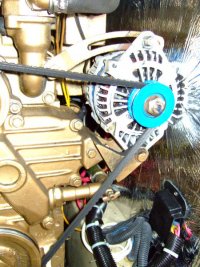Shadowfax
Member III
I'm posting this to the list in the hope that it may be of service to someone thinking of this upgrade. I originally wrote this to Tom Metzger, resident electrical engineer and my personal electrical guru, who helped me thought the decision process and the mechanics of the installation. Thanks again Tom>
Tom,
The installation of the Balmar 6 series 100 amp alternator and the Xantrex regulator is complete. I thought I’d give you the blow by blow since you where of so much help in the design.
As we discussed, I at first was told that I didn’t need to get a new alternato,r as much as I needed a “smart” regulator. After discussions with you and my guy at the marina it became obvious that I could go that route, but I’d probably burn the existing alternator up pretty quickly and most likely at the most inopportune time. So I the purchase of the 6 series Balmar alternator, which has the option of using an onboard regulator, or disabling it, for use with a remote regulator, with the idea that if the external regulator fails, you can very easily switch back to the internal. I followed your advise and bought the 100 amp, even though it wanted the ½ inch belt and the Universal M 25 XP has 3/8 pulleys. Mine, like yours, runs proud of the engine pulleys. The belt is a Napa 7405 XL. I bought the universal mounting bracket offered by Balmar, but it didn’t work and my guy made up a custom one. We where concerned about the compatibility of the Balmar alternator to the Xantrex regulator, so we [re. he] called Balmar and was informed that they make the Xantrex regulator for them, so there where no compatibility issues. Interesting!
There where wiring issues. My guy upgraded the lead wires to #6 and removed the amp meter and replaced it with a volt meter at the panel in the cockpit to improve the loss rate in running a wire to the panel and back. I think you did the same. Not a problem as the Link 10 will give me a better idea of amps then the cockpit meter ever did.
I plan on going around this weekend, so I’ll see how it works; it has been test run and works, but there is nothing like a field test. As in the words of Capt. Ron, “If it’s going to go wrong, Boss, it will go wrong out there.” I’ll let you know how it goes.
I’ll put this on the Ericson.org site in case someone might be contemplating the same upgrade.
Tom,
The installation of the Balmar 6 series 100 amp alternator and the Xantrex regulator is complete. I thought I’d give you the blow by blow since you where of so much help in the design.
As we discussed, I at first was told that I didn’t need to get a new alternato,r as much as I needed a “smart” regulator. After discussions with you and my guy at the marina it became obvious that I could go that route, but I’d probably burn the existing alternator up pretty quickly and most likely at the most inopportune time. So I the purchase of the 6 series Balmar alternator, which has the option of using an onboard regulator, or disabling it, for use with a remote regulator, with the idea that if the external regulator fails, you can very easily switch back to the internal. I followed your advise and bought the 100 amp, even though it wanted the ½ inch belt and the Universal M 25 XP has 3/8 pulleys. Mine, like yours, runs proud of the engine pulleys. The belt is a Napa 7405 XL. I bought the universal mounting bracket offered by Balmar, but it didn’t work and my guy made up a custom one. We where concerned about the compatibility of the Balmar alternator to the Xantrex regulator, so we [re. he] called Balmar and was informed that they make the Xantrex regulator for them, so there where no compatibility issues. Interesting!
There where wiring issues. My guy upgraded the lead wires to #6 and removed the amp meter and replaced it with a volt meter at the panel in the cockpit to improve the loss rate in running a wire to the panel and back. I think you did the same. Not a problem as the Link 10 will give me a better idea of amps then the cockpit meter ever did.
I plan on going around this weekend, so I’ll see how it works; it has been test run and works, but there is nothing like a field test. As in the words of Capt. Ron, “If it’s going to go wrong, Boss, it will go wrong out there.” I’ll let you know how it goes.
I’ll put this on the Ericson.org site in case someone might be contemplating the same upgrade.



